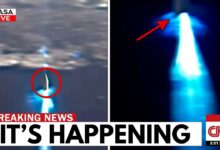James Webb Telescope’s Final Discovery on Proxima B CONFIRMS what WE ALL FEARED

Proxima B: The Exoplanet That Has Captivated Humanity
Just over 4 light-years away from Earth, Proxima B is a mysterious planet orbiting the red dwarf star Proxima Centauri. Although similar in size to Earth and located in the habitable zone where liquid water could exist, this planet is far from hospitable. One of its most striking features is tidal locking—one side of the planet permanently faces its star, while the other is locked in eternal darkness. This creates extreme temperature differences, from scorching heat to freezing cold. Yet, the “twilight zone”—the narrow area between day and night—may offer conditions suitable for life, with temperatures mild enough for liquid water.
However, where there’s hope, there’s also danger. Proxima B is regularly bombarded by intense radiation from stellar flares. These bursts could strip away the atmosphere and destroy any form of life. Despite these hazards, the twilight region remains a beacon of possibility in our quest to find life beyond Earth.
The James Webb Space Telescope—the most powerful of its kind—has detected strange, unexplained light signals coming from the planet’s dark side. While some suggest natural causes like volcanic activity or auroras, the intensity and regularity of these signals have raised suspicions: could this be a sign of alien technology?
If the lights are artificial, it may point to the existence of an advanced civilization. Are they trying to communicate—or to hide?
Tidal locking not only leads to harsh conditions but also fuels violent storms caused by extreme temperature contrasts. Yet, life on Earth thrives even in the most extreme environments—at the bottom of the oceans and in frozen wastelands. This inspires scientists to believe that life can adapt anywhere, even on Proxima B.
Red dwarf stars like Proxima Centauri are the most common in our galaxy, but they are highly unstable, often emitting dangerous radiation. While this threatens nearby planets, it also means their habitable zones are closer in—making Earth-like planets easier to detect.
Webb has also picked up faint traces of gases—possibly water vapor and carbon dioxide—in Proxima B’s atmosphere. But without a strong magnetic field like Earth’s, this atmosphere could be eroded by stellar winds. Did Proxima B once harbor a thriving ecosystem? And if there’s water, could the other building blocks of life be present?
Intriguingly, ice might exist along the border between the planet’s day and night sides—an area where temperatures allow ice to melt and refreeze. This could support the presence of underground lakes, ideal environments for microbial life.
Even though a journey to Proxima B would take decades with current technology, projects like Breakthrough Starshot are laying the groundwork. But even if we reach it, we’ll still face unknown terrain, harsh weather, and dangerous radiation.
Still, the potential rewards are enormous—not just the possibility of finding life, but also gaining insight into our own planet. Proxima B serves as a mirror, showing us what could happen if Earth lost its magnetic field or atmosphere—a vivid warning of what’s at stake.
While many questions remain, each discovery about Proxima B brings us closer to answering the biggest one of all:
Are we alone in the universe?








